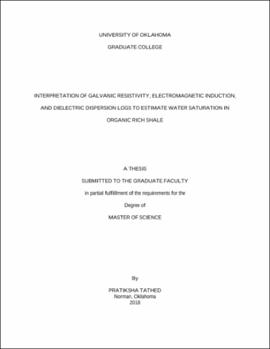| dc.description.abstract | Water saturation estimation based on electrical and electromagnetic logs in organic-rich shale reservoirs is challenging due to effects of clay and conductive minerals. Presence of nanopores, low porosity, interfacial polarization effects, and highly anisotropic tortuous paths in organic-rich shales and tight hydrocarbon-bearing formations results in breakdown of conventional models for purposes of water saturation estimation. These petrophysical attributes lead to disagreement between water saturation estimates obtained using different approaches, such as Nuclear Magnetic Resonance (NMR), Induction, Dielectric, and Dean-Stark retort measurement method. Few of the above-mentioned challenges in water saturation estimation can be addressed by jointly processing the subsurface galvanic resistivity, induction, propagation and dielectric dispersion logs using an integrated mechanistic model that accounts for various frequency-dependent interfacial polarization mechanisms.
Single-frequency galvanic resistivity (laterolog) or single-frequency induction resistivity and multi-frequency dielectric dispersion logs, comprising 4 conductivity and 4 dielectric permittivity logs measured at four distinct frequencies were acquired in few wellbores drilled in Wolfcamp and Bakken shale formations. We implement a novel log-interpretation technique for the improved estimation of water saturation (S_w), brine conductivity (C_w), textural index/cementation exponent (m), and saturation exponent (n). The proposed log-processing workflow uses an integrated mechanistic model, which combines Complex Refractive Index (CRI) model to analyze the conductivity and permittivity logs acquired at 1 GHz, Stroud-Milton-De (SMD) model to analyze the 3 conductivity dispersion and 3 permittivity dispersion logs in the frequency range of 10 MHz to 0.3 GHz, and Waxman-Smits (WS) model to analyze the single-frequency deep galvanic resistivity log (RLA5) acquired at 1 kHz or the single-frequency induction resistivity (AT90) log acquired at 20 kHz. Petrophysical estimates derived from the joint inversion were robust in the presence of pyrite, low water saturation, and low porosity as compared to the petrophysical estimates from the inversion of only four-frequency dielectric dispersion logs or those from the single-frequency resistivity log.
Based on the petrophysical estimates from the proposed methodology, formation brine conductivity and saturation-exponent estimates are more reliable compared to water saturation and cementation exponent estimates. Water saturation estimates obtained using the proposed methodology are compared against those obtained using multi-mineral inversion and CRIM model and those from NMR log, Dean-Stark core measurements and service company’s dielectric inversion. Average relative errors in fitting the 1 laterolog resistivity and 8 dielectric dispersion logs using the estimates obtained from the proposed method are 10% and 20%, respectively, and their extreme values are 55% and 60%, respectively, in the 520-ft depth interval of the upper Wolfcamp shale formation. Average relative errors in matching the 1 induction resistivity and 8 dielectric dispersion logs using the inversion-derived estimates are 33% and 20%, respectively, in the 350-ft depth interval of Bakken Petroleum System (BPS).
Water saturation and formation brine conductivity estimates in Middle Bakken are in the ranges of 0.5 to 1 and 25 S/m to 45 S/m, respectively. In the Upper Wolfcamp formation, water saturation estimates are in the range of 0.4 to 1 and connate water conductivity are in the range of 5 S/m to 30 S/m. | en_US |
